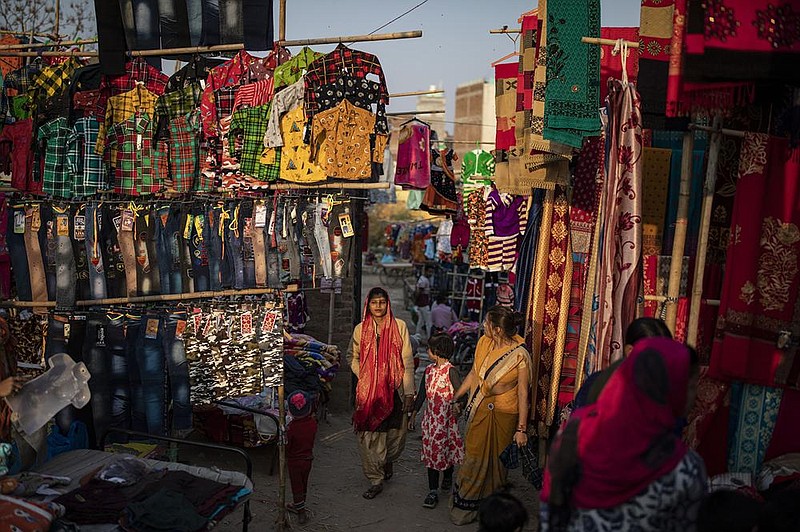NEW DELHI -- China has come roaring back from the devastation of covid-19, and the United States, Europe and Japan are finding their feet in some respects. But the hundreds of millions of laborers and shopkeepers who keep India's economy running still cannot find relief.
India's economy shrank 7.5% in the three months that ended in September compared with a year earlier, government figures showed Friday. The drop followed a record slump of 23.9% in the April-June quarter.
The contraction occurred despite the government's lifting of a strict two-month lockdown imposed across the country in March after the outbreak of the pandemic.
The data reflects the deepening of India's severest recession since at least 1996, when the country first began publishing its gross domestic product numbers. A country enters a technical recession if its economy contracts for two successive quarters.
The new figures firmly ensconced India's position among the world's worst-performing major economies, despite expansive government spending designed to rescue the thousands of small businesses severely battered by its long, hastily imposed lockdown.
[CORONAVIRUS: Click here for our complete coverage » arkansasonline.com/coronavirus]
Manufacturing grew by 0.6% in July-September after shrinking by 39% in the preceding quarter, the report said. While the agriculture sector grew by 3.4%, trade and services contracted by 15.6%, it said.
Nikhil Das, 62, a manufacturer of silk ties and scarves in New Delhi, says his business is teetering on the edge of collapse. His sales, which depend on demand from luxury shops and airport retailers, have fallen by 80%. He needs payments from customers to make up for his manufacturing costs, but retailers who cannot move his wares still owe him more than $50,000.
He has idled six workers he once paid for each tie and scarf they made, and he has been treated for stomach pain that his doctor has attributed to stress.
"The money supply chain is broken," Das said. "It is a constant source of tension to me."
The Indian government has committed $50 billion, roughly 2% of India's annual economic output, to help small businesses, as well as cash transfers to low-income workers as part of a $266 billion economic package.
'MASS DESTRUCTION'
For the average Indian worker and entrepreneur, it has not been enough.
An estimated 140 million people lost their jobs after India locked down its economy in March to stop the outbreak, while many others saw their salaries drastically reduced, the Center for Monitoring Indian Economy in Mumbai said. As the lockdown was eased, many went back to work, but more than 6 million people who lost jobs have not found new employment.
In a June survey by the All India Manufacturers Organization, about one-third of small and medium-size enterprises indicated that their businesses were beyond saving. The industry group said that such a "mass destruction of business" was unprecedented.
Businesses like Das' form the backbone of India's still-developing economy. Small and medium-size enterprises employ about 80% of the labor force.
India's textile factories, leather tanneries, brick kilns, foundries and other small enterprises form "part of the country's social fabric, bringing local wealth and local employment," said Venkatachalam Anbumozhi, an economist who focuses on South and East Asia.
TROUBLE BEFORE PANDEMIC
But India's economy was facing head winds well before the pandemic. Between April and December 2019, gross domestic product grew only 4.6%.
"India was expected to really step into China's shoes and give that additional boost to globalization that was missing," said Priyanka Kishore, head of South Asia at Oxford Economics. "And that's where India didn't really play out the role it was largely expected to play, and that role seems to be diminishing more and more."
Since coming to power in 2014, Prime Minister Narendra Modi has shaken the economy with policies meant to boost government revenue and help India's transition to digital banking. Some of the efforts have been embraced by business, such as Modi's pledges to slash the country's vast and tangled web of red tape.
DISRUPTIVE POLICIES
But other Modi initiatives meant to bring India's informal, off-the-books economy into the open proved disruptive for many small businesses, which don't have the resources that big companies can deploy to overhaul how they make payments and keep their books.
One of Modi's policies, called demonetization, banned large currency notes overnight in an effort to crack down on tax avoidance and money laundering. Under another, India replaced its welter of national and state taxes with a single value-added tax, in part to cut down on corruption among tax collectors.
Modi also increasingly turned India's industrial policy inward, which many economists say has hurt overall growth.
"The slowdown," Kishore said, "is almost homegrown."
That stumbling economy was dealt a sharp shock by the coronavirus.
Even after the pandemic wanes, Kishore projects, India will be the worst-affected among the world's major economies. Debt-laden companies will have to borrow even more. Growth could fall to 4.5% annually over the next five years, well below the 6.5% growth that had been projected before covid-19.
"The worst," said Anbumozhi, the economist, citing the potential impact to small business in particular, "is yet to come for India."
Information for this article was contributed by Emily Schmall of The New York Times and by Ashok Sharma of The Associated Press.
